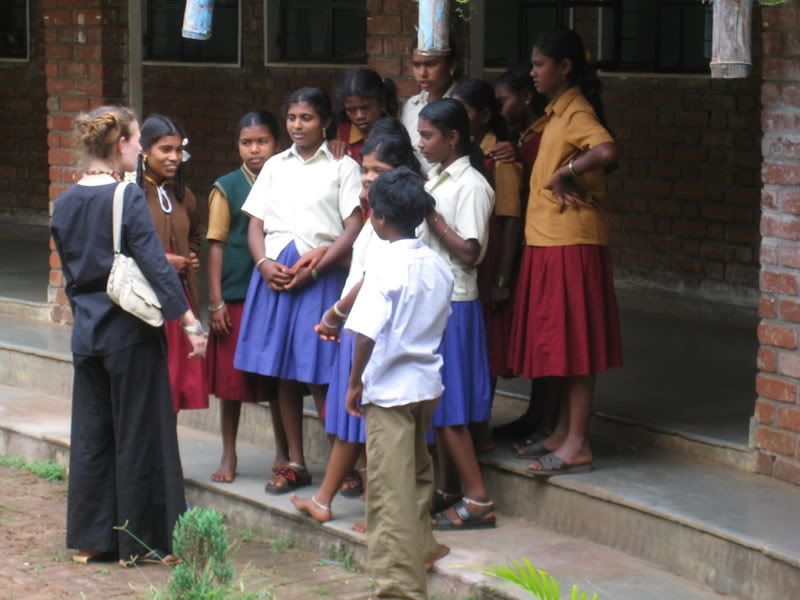
Aspiring media darlings and lovers of the limelight: forget making it big in the States. Come to India instead. All you have to do is dust off that American accent and you’re an instant star. No preparation required.
I’ll break it down with some good old-fashioned stereotyping: the Irish adore their beer, Americans their money, Italians their wine, and the Aussies their now dearly departed Steve Irwin. The thing that gets Indian toes a-tapping is foreigners. “What country?” has skyrocketed to the top of my list of questions-people-ask-me, beating out even the standard assessment tool of colligates: “What’s your major?” In Mahabalipuram outside of Chennai, where the humidity and sun were so intense that the mere act of breathing is equivalent to an intensive full-body work out, Indians were clamoring to be photographed next to me. I graciously declined all offers, haunted by nightmares of my feverishly flushed and sweaty face making it into some family photo album. I’m not sure when standing next to a half-melted American became a Kodak-worthy event, but it definitely makes for a photograph in serious demand among camera-wielding Indians.
School pens, like unattractive pictures, are a currency all on their own. I may never understand why, but Indian girls and boys definitely find panache in being able to take notes in American ink. To make matters worse, Indian youngsters are ubiquitous; I’m beginning to suspect that teachers put class on hiatus when a foreigner comes into town just so one or two of the children can retrieve a coveted American writing utensil for show and tell. When I venture out into the streets or temple areas of India, I’m guaranteed to hear at least one voice beseeching me with, “Mah-dahm, skoo pen?” Don’t be fooled by the sweet, plaintive tone, though—it’s merely a cover. Just like the United States had beanie babies and Tickle Me Elmo to create frenzies among present-buying mothers, the school pen turns Indian children into greedy, wild savages. The one time that I did have a pen on me to give a child, a dogpile had formed on top of the boy in the millisecond before my offering even had a chance to leave my hand. Mind you, the pen that caused the fracas was the plainest and most boring pen imaginable; it was a solid white tube with a blue cap, one of fifteen from an off-brand, Big Lots multipack that probably cost no more than $1. It didn’t even have writing on it, so there was nothing that made it particularly American. I can only imagine the pandemonium that would have ensued from something with color or a retractable point.
The celebrity that Indians associate with foreigners is automatic and unconditional. At times, it’s a pest. Indian men must liken Western woman to porn stars: our appreciation for clothes that reveal both the ankles and the shoulders is of course a sure sign of unconscious nymphomaniac tendencies, like a Freudian slip of the wardrobe. Either way, it’s not considered a breach of etiquette in India to stare, and so stare the men do. Liberally. Openly. Not always so comfortably. It’s those times that you’re sitting in a restaurant trying to digest your fresh lime soda and Gobi Manchurian (arguably the best use of cauliflower ever discovered by man) with twenty pairs of eyes fixedly analyzing your eating habits that you find yourself cursing India’s foreigner fixation.
But it’s those other times, like when you find yourself at the Viveka Tribal Center for Learning, that you couldn’t feel more touched by this unwarranted and undeserved stardom. A cultural excursion landed us at the school right in the middle of its prime time for learning, so that we could meet the children and they could meet us. The students gathered in throngs when our bus pulled up. As we stepped off, we were welcomed with choruses of “Hello!” and “Good morning!” Young faces, 150 strong, stared at the group of us like we were The Beatles, or Audrey Hepburns, or Brad Pitts. They didn’t know our names or what our personalities were like—they didn’t even know that we would return their exuberant greetings—but they stared at us like were amazing. To them we were: we were foreigners. We came with our digital cameras, our clean and quality clothes, our obligatory educations, and our infinite school pens. Most of these children were first generation students; no one in their family had set foot in so much as an elementary school before them. As we wandered through the campus, kids from the “third standard,” without a teacher in sight, ran into their classroom and belted out the ABCs so they could show off to us how much they know. Girls from the “fourth standard” recited a prayer for us so we could hear the words. Others begged us to sing them American songs, taught us that “white” is “bili” in Kannada, asked us our names and shyly provided their own in return. As I passed by a classroom in the middle of reciting the alphabet, my eyes met those of a girl in the front row who, surprised, promptly forgot to continue reciting. I grinned and waved at her, and a bashful, sheepish smile stretched across her face. In that smile, all the unpleasant ogling in the world became unimportant.
India is extremes and contrasts. In the time it takes to breathe (or to break a sweat if you happen to be visiting Mahabalipuram), the things about it that you hate the most can become the things about it that you love, and the memories that you will treasure for years arise from the experiences that you started off thinking were worthless. You have to keep on your toes here: India, like any good media sweetheart, is all about the drama.



No comments:
Post a Comment